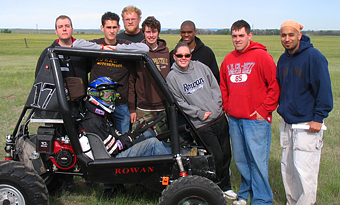Rowan Engineering Students: "Let's Get Clinical"
Rowan Engineering Students: "Let's Get Clinical"

In May, a team of Rowan University mechanical engineering students hauled a hand-built Baja car out west and raced it on the rutted plains.
The gas-powered dune buggy was the product of countless hours that
well exceeded the minimum required for the students' junior/senior
clinic project and they had boatloads of time, inspiration and
perspiration vested in it.
And so, as with any labor of love, the students gave their creation its due: they trounced the car in an off-road race and rolled it in a ditch.
"I was on my second lap and there was this big hill climb," recalled senior Tricia Wright, 21, of Mullica Township. "All of a sudden there was a four- or five-foot cliff. The nose planted and we went end-over-end."
But Wright, strapped into the vehicle with a racing-style four-point harness, wrist restraints, head and neck padding, helmet and goggles, didn't feel a thing.
"This guy came over and asked if I was alright," she said. "I was like, 'Dude, that was so much fun!' I was totally safe."
One of three Rowan drivers to roll the craft during the Society of Automotive Engineers' Mini Baja in South Dakota, Wright said the team still bested some 60 college and university squads, many of which competed in the rally since its inception in the 1970s.
"For us to place 44th may not sound so great but we're really proud of ourselves," she said. "It's only our 5th year."
The Baja program is one of more than 50 junior/senior clinics to combine engineering theory with real-world application. It's a merger that's setting Rowan's College of Engineering apart and, as in the case of this year's Baja car race, leaving many competitors in the dust.
Dr. Eric Constans, an associate professor of mechanical engineering who helped run the automotive engineering clinic in 2006-07, said clinics must challenge students and the Baja project is a natural.
"Everything besides the engine and brake calipers are homemade," he said. "It's something where you really get to see the fruits of your labor but it's a huge amount of work."
Constans said each college or university Baja team starts with a rulebook and a 10-horsepower Briggs & Stratton engine that they may not modify. The team's mission is to design a vehicle that is light, strong and fast but virtually everything, from the transmission and differential to the tubular frame and tires, must be assembled from scratch.
"Part of the challenge is to work within the constraints,"
Constans said. "Anybody can make a car with unlimited horsepower go
fast."
The Med School Model
Rowan's engineering clinics are based on the medical school model
in that they partner faculty with students for intense, hands-on
scholarship.
The eight-semester program begins freshman year with an overview and a series of modules that expose students to all four disciplines -- Chemical Engineering, Civil and Environmental Engineering, Electrical and Computer Engineering, and Mechanical Engineering.
In their second year, students in the sophomore clinic learn engineering theory as well as communication techniques so they can better express their ideas in the workplace.
While the freshman/sophomore clinics lay the foundation, the
junior/senior clinics give students their first real taste of
engineering. Clinic projects change most years but run the gamut
from automotive research and design to robotics to the development
of new biological organisms that may one day help solve the world's
dependence on fossil fuel.
Future tech
In 2006-07 Dr. Peter Jansson, an associate professor of electrical
and computer engineering, directed his clinic students in the study
of alternative energy projects that included the design and
installation of solar panels on the team house roof.
Jansson said the study of photovoltaic energy makes for an excellent clinic project because research into renewable energy sources is so vital to the future of the planet.
"These clinics involve real projects that real engineers work with all the time," he said. "It's only natural that our students take on projects that can have an impact."
Graduate student Ryan McDevitt, who studied under Jansson in 2006-07, said the work spoke to his desire to help reduce global warming.
"It's very important," he said. "As engineers we have an obligation to help fix the planet before its too late."
In addition to the solar panel project, McDevitt, 22, of Williamstown, said he and his classmates built 30-meter towers to collect air data at potential windmill sites. He said that project, begun in 2005, resulted in the positioning of eight data towers around New Jersey.
McDevitt seeks a career in renewable energy and believes the work he did in Rowan's engineering clinics will help him get there.
"The field's wide open and I'll be ready," he said.
Redesigning drugs
In another section of Rowan Hall, the university's home to the
College of Engineering, chemical engineering students in 2006-07
worked at perfecting a process used to manufacture
pharmaceuticals.
Their clinic, sponsored by pharmaceutical maker Novartis, involved removing metal catalysts from the product stream after specific chemical reactions were completed but before the final drug was produced.
Dr. Brian Lefebvre, assistant professor of chemical engineering, said the experiments were similar to those performed by actual Novartis researchers.
"Our goal is to produce students who know more than theory," Lefebvre said. "Students like the experiments because they actually see how some of the stuff they're doing is going to be applied."
Sonia Berberena, 22, studied chemical engineering under Lefebvre and had a full-time job waiting for her upon graduation in May. Now a production engineer with Geo Specialty Chemicals in Greenwich Township, she said the experience of real work in the clinics was a big factor in landing her first job.
"It gave me experience with real world problems," she said. "In
the workplace there's research, time management and project
management issues, all of which we dealt with."